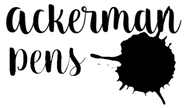Using our overfeeds
Our overfeeds are simple devices designed to let you draw wider lines for a longer time using flexible pointed nibs. Here's a view of three overfeeds placed in positions so you can view their entire shape.

Our overfeed looks like a large nib because its shaped to fit over large pointed nibs. In most cases, you can use the overfeed out of the box.
When you receive a pen containing an overfeed, it looks like the pens shown below.

When you draw with an overfeed and flex the nib by pressing down on the nib, you can vary the thickness of your drawn line as shown below.

This was drawn with our Classic Fountain Pen containing a Zebra Manga G nib and an overfeed.
The best flexible pointed nibs are designed to draw and write with a very thin line when you haven't yet flexed the nib. The flex in the nib lets you press down on the nib to expand the tips and leave a broader line. The width of the line you draw is determined by how much you press the nib to the paper.
Our overfeed does two things - it stores more ink on top of the nib, and it feeds the extra ink to the tip of the nib when the nib flexes. The term "overfeed" distinguishes it from the underfeed or the feed under the nib. The underfeed must be rigid to support the nib. The overfeed must be flexible to let the nib flex up and back.
Our overfeeds can increase the thickness of the lines you draw with a pointed nib ten fold, which means your thickest line will be ten times wider than your thinnest line. This contrasts with the standard flex without an overfeed, which is about half as wide.
Note: Our overfeeds only fit our Classic pens that have been configured for them. You cannot use our overfeeds in other pens or in Classic pens that have not been configured for them.
Nibs you can use
We provide overfeeds for Classic pens that contain large flexible pointed nibs including:
- Manga G nibs made by Nikko, Tachikawa and Zebra
- Brause nibs Bandzug, Ornamental and Rose
- Principal nibs made by Leonardt
- Our Sketch and Music nibs
You can use other nibs of a similar shape and size, such as the Hunt 101.
Working with new overfeeds
If you’re working with a new overfeed, make sure there is a slight bend or arch in the stem or protruding piece of the overfeed - just a slight bend as shown below.

The arch helps store more ink and provides a space for air to flow back into the pen. The overfeed might flatten out over time and through use. Test the angle of the arch - you might find it works better with more or less curvature. Just bend it slightly with your fingers.
Removing and inserting overfeeds
To clean or replace the feed or nib, pull out all three items as a unit. If the overfeed is stuck, you can slide out the nib and underfeed first, then press the sides of the overfeed slightly to unwedge it from inside of the pen.
You can reinsert the three items the same two ways - one piece at a time or altogether. To insert each piece one by one - push the underfeed in first and make sure it seats in place, then push the nib in over the feed, and finally push the overfeed over the nib and underfeed.


Be careful when pushing in the overfeed so you don't stab your finger with the point of the nib.
Finding the "sweet spot"
Once the feed, nib and overfeed are inserted, slide the nib back and forth to find the sweet spot where the flow works best. Start with the tip of the nib extending beyond the tip of the overfeed. The more nib you expose, the more flex you will get. The overfeed doesn't prevent the nib from flexing, it just constrains it a bit. You can correct the positions of the nib and overfeed while you're drawing. Use a piece of paper or bit of rag to shield your fingers from too much ink.
Make sure the tip of the overfeed doesn’t point off to one side of the nib. Correct this by pushing the tip back into alignment.
Press down on the overfeed with your thumb and slide it forwards or backwards to the right position.
Once everything is in place, rotate the pen a few times to encourage ink to drip off the nib and climb onto the top of the nib and fill in the space between the overfeed and nib.
Removing overfeeds
You can remove the overfeed if you don't want to use it. You must replace the overfeed with a collar to maintain the same inernal configuration of the front of the pen.
Note: Collars are a new product to be released beginning January 2025.
Collars are simple tubes, as shown below.

You must press the overfeed collar into the front of your pen far enough so it seats firmly at the back. Your pen will then look like those shown below with and without nib and underfeed.


The rim of the collar extends out of the pen to help when you want to remove the collar. You can switch back to using an overfeed by removing the collar and reinserting the overfeed. The fit of the collar is tight to prevent leakage, so you should be handy with tools and careful with your work. If you dent or lose the collar, you can buy a replacement.
It's more difficult to remove a collar than insert it. For this reason we suggest you don't remove the overfeed unless you are handy working with small parts and you have a safe place to store the parts when not in use. You can order replacement overfeeds and overfeed collar.
